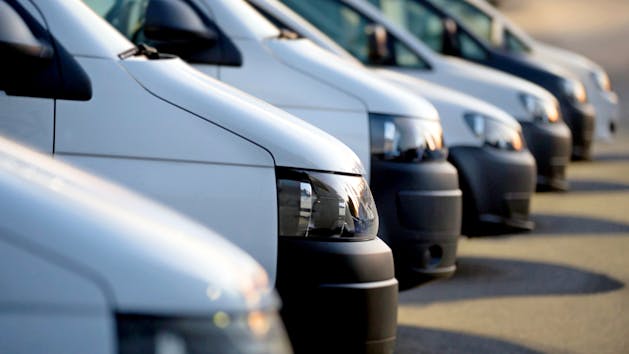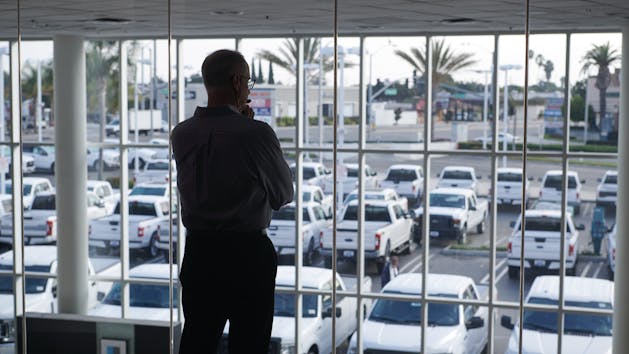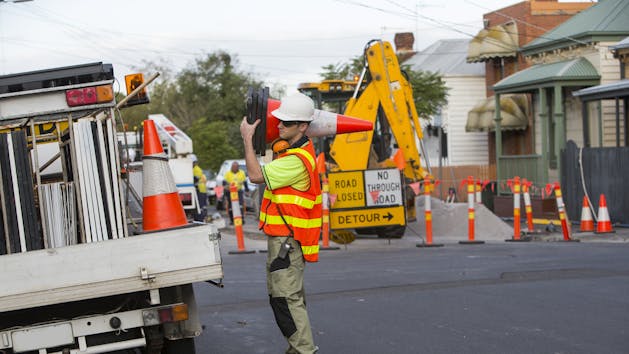Find the right solution for your business with our free Fleet Management Buyer’s Guide.
5 Ways Companies with Truck Fleets will Use Drones
The rise of drones, both in the air and on the ground, promises to reinvent freight logistics across the U.S. – and eventually the world. We're already witnessing the early effects that drones are having on the construction and engineering sector, and it's likely that many of the same use cases will soon apply to trucking and shipping.
For logistics managers and fleet operators, the prospect of integrating drones might seem a little futuristic. Even though freight transportation has made technical leaps in the last few years, there are practical concerns that might present challenges to the adoption of drones: drivers may view drones as a threat to their jobs; drones raise the prospect of increased risks, at least superficially; and there is regulatory uncertainty as commercial drone regulations continue to adapt and change.
But for those forward-looking logistics managers who see the potential for drones to enhance their business – potentially saving millions of dollars in worker hours and miles driven, increasing efficiency, reducing waste, and improving the safety of their operations from top to bottom – there is a great opportunity to become an early adopter and establish drones as part of the workflow.
To give you a sense of how drones can help companies with fleets of trucks run more efficiently, here are a few ways that companies are already using drones—and one case that’s just over the horizon.
1. Optimized storage infrastructure
When was the last time you inspected your warehouse infrastructure – the building itself, not just the people or equipment inside? Drones are emerging as one of the best and most efficient ways to perform building inspections, allowing you to check every inch of a structure, including the roof and walls, without putting a worker at risk on a ladder or climbing on the roof. This use case has been successfully put to work in the construction industry, and every company with warehouses or loading docks can learn from these successes.
A drone equipped with a standard HD camera can inspect a building’s flashing for any signs of leakage and insulation for cracks. Throw a FLIR (forward looking infrared) sensor on there, and you're able to get a clear overview of your entire HVAC system. For companies that rely on climate-controlled storage spaces, identifying weaknesses and inefficiencies in heating and cooling systems is essential, and with a drone an inspection can be performed regularly at a low cost. The same technology can also be used to inspect the electrical system and identify hot spots, potentially averting electrical fires.
2. More efficient inventory management
In a warehouse with thousands of square feet of floor space and multiple levels of shelving, it can be difficult and time-consuming to locate a particular item at the drop of a hat. Drones can help find objects, both in warehouses and surrounding outside spaces, by using a comprehensive system of barcodes and RFID tags. Though they won't be able to outright replace human workers in the short-term, unmanned aircraft can be integrated into a warehouse to improve administration systems and pre-dispatch processes. With a little rearranging, you can reduce errors and save both time and money in the long run.
3. Surveillance of inventory and infrastructure
Since last year, a major ports company has been using a pair of drones to monitor ships with high-value cargo. Unlike stationary security cameras, which can be disabled, obscured, or avoided, a mobile drone with a high-quality camera and its own data transfer system is a far trickier security system for thieves to tackle. In the event of an incident, the drones' onboard GPS systems make it simple to track down the source of the trouble, and the data they capture is easily retrievable. When combined with an array of traditional cameras, the drones make for a security system that can adapt to enterprising intruders.
Though this use case has only been applied to a shipyard as of this writing, it would be feasible to implement in a large warehouse or depot. Of course, there are some regulatory considerations to keep in mind, particularly in regards to flying at night (which requires a waiver from the FAA), and you must be certain that you are not operating in restricted airspace. To quickly check whether there are airspace restrictions near a warehouse, Skyward offers an up-to-date drone airspace map. Skyward is an FAA-acknowledged UAS Service Supplier for airspace authorization in U.S. controlled airspace.
4. Monitoring the workplace
Warehouses are vast spaces that frequently contain hard-to-reach areas that are unsafe or impractical for workers to access. This creates ample opportunity for a small, agile drone to monitor the inventory, infrastructure, and personnel that would otherwise be difficult to oversee adequately with a traditional monitoring system, whether that be stationary cameras or human observers.
At the very least, drones will be able to monitor loading docks, which are frequent sites of accidents. With an eye in the sky, you can be sure that the proper safety procedures are being followed and no unsafe practices are happening under your watch.
5. Last-mile logistics
So far, this article has discussed drone use cases that are already being widely used. But we would be remiss if we failed to mention probably the most famous use case for drones in the trucking industry – last-mile logistics. While this application is still being tested, there will come a time when drones will be used for home delivery and for supply-chain delivery.
The current model involves a truck driving to an urban neighborhood and deploying a fleet of cargo-laden drones. Currently, regulations support a maximum freight capacity of around ten pounds. These drones would fly to the address of the recipient and deposit the package at its final destination.
The carrying capacity of drones is a clear limitation of this use case, and the current regulations are unclear on whether this is legal in the first place (Who is operating these drones? Are they in the line of sight of the operator? Is there one operator per drone? What about airspace restrictions?). But it's also easy to see how last-mile delivery could save trucking and shipping companies a whole lot of money. The last mile is the most expensive and inefficient part of the logistics chain, so any increased efficiencies will save even companies with small fleets a lot of money.
Becoming an early adopter
Other industries have already gone through the first stages of adopting drones, increasing efficiency and safety all at once, but a well-implemented drone program could offer the trucking industry exactly that. Though the regulations still have a long way to go in terms of unleashing the full transformative potential of the technology, the law as it stands today still offers trucking and logistics companies plenty of opportunity to make their processes safer, more efficient, and more profitable. If you're still worried about risk, Skyward can help you address regulatory requirements and maintain operational soundness of your drone program.
Skyward, a Verizon company, helps companies launch and run safer, efficient drone operations. Like operating a fleet of vehicles, drones require logistical, safety, and regulatory oversight. Between dynamic airspace, evolving regulations, operator certifications, maintenance, and job specifications, there’s a lot to keep track of—more, if you operate in multiple jurisdictions. Skyward’s operations management platform gives businesses one place to manage it all.
Find out how our platform gives you the visibility you need to get more done.



